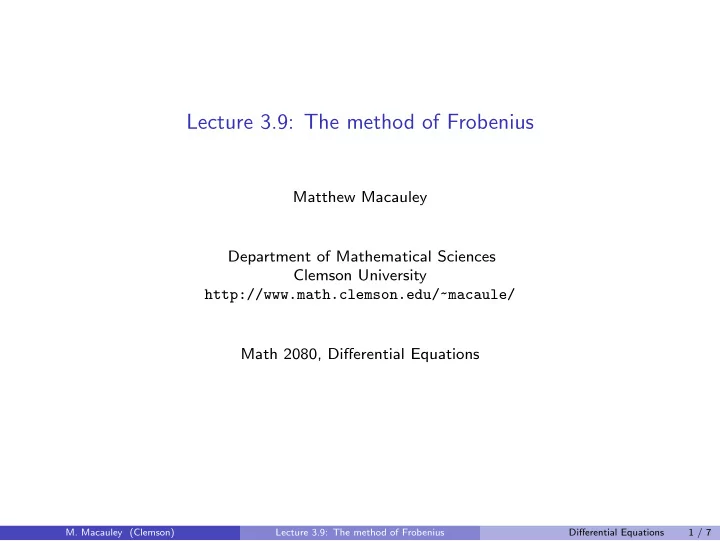

Lecture 3.9: The method of Frobenius Matthew Macauley Department of Mathematical Sciences Clemson University http://www.math.clemson.edu/~macaule/ Math 2080, Differential Equations M. Macauley (Clemson) Lecture 3.9: The method of Frobenius Differential Equations 1 / 7
Quick review of power series Definitions A power series centered at x 0 is a limit of partial sums: N ∞ a n ( x − x 0 ) n = � � a n ( x − x 0 ) n . lim N →∞ n =0 n =0 It converges at x if the sequence of partial sums converges. Otherwise, it diverges. Examples N 1 n ! x n converges to e x for all x ∈ ( −∞ , ∞ ). � The power series lim N →∞ n =0 N 1 ( − 1) n x n converges to � The power series lim 1 + x for all x ∈ ( − 1 , 1). It diverges N →∞ n =0 at x = 1. Radius of convergence ∞ a n ( x − x 0 ) n converges. � The largest number R such that if | x − x 0 | < R , then n =0 M. Macauley (Clemson) Lecture 3.9: The method of Frobenius Differential Equations 2 / 7
Ordinary vs. singular points of ODEs Definitions ∞ a n ( x − x 0 ) n for some R > 0. � A function f ( x ) is real analytic at x 0 if f ( x ) = n =0 Definition Consider the ODE y ′′ + P ( x ) y ′ + Q ( x ) y = 0. The point x 0 is an ordinary point if P ( x ) and Q ( x ) are real analytic at x 0 . Otherwise x 0 is a singular point, which is: regular if ( x − x 0 ) P ( x ) and ( x − x 0 ) 2 Q ( x ) are real analytic. irregular otherwise. Example Consider the homogeneous ODEs y ′′ + x 2 y − 4 y = 0. M. Macauley (Clemson) Lecture 3.9: The method of Frobenius Differential Equations 3 / 7
Regular vs. irregular singular points More examples 1. (1 − x 2 ) y ′′ − xy ′ + p 2 y = 0. 2. x 3 y ′′ + y ′ + y = 0. M. Macauley (Clemson) Lecture 3.9: The method of Frobenius Differential Equations 4 / 7
When does an ODE have a power series solution? Theorem of Frobenius Consider an ODE y ′′ + P ( x ) y ′ + Q ( x ) y = f ( x ). If x 0 is an ordinary point, and P ( x ), Q ( x ), and f ( x ) have radii of convergence R P , R Q , and R f , respectively, then there is a power series solution ∞ a n ( x − x 0 ) n , � y ( x ) = R = min { R P , R Q , R f } . n =0 If x 0 is a regular singular point and ( x − x 0 ) P ( x ), ( x − x 0 ) 2 Q ( x ), and f ( x ) have radii of convergence R P , R Q , and R f , respectively, then there is a generalized power series solution ∞ y ( x ) = ( x − x 0 ) r � a n ( x − x 0 ) n , R = min { R P , R Q , R f } , n =0 for some constant r . M. Macauley (Clemson) Lecture 3.9: The method of Frobenius Differential Equations 5 / 7
An ODE with a generalized power series solution Example 5 Solve the homogeneous differential equation 2 xy ′′ + y ′ + y = 0. M. Macauley (Clemson) Lecture 3.9: The method of Frobenius Differential Equations 6 / 7
Applications of the power series method Examples from physics and engineering Cauchy-Euler equation: x 2 y ′′ + axy ′ + by = 0. Arises when solving Laplace’s equation in polar coordinates . Hermite’s equation: y ′′ − 2 xy ′ + 2 py = 0. Used for modeling simple harmonic oscillators in quantum mechanics . Legendre’s equation: (1 − x 2 ) y ′′ − 2 xy ′ + p ( p + 1) y = 0. Used for modeling spherically symmetric potentials in the theory of Newtonian gravitation and in electricity & magnetism (e.g., the wave equation for an electron in a hydrogen atom) . Bessel’s equation: x 2 y ′′ + xy ′ + ( x 2 − p 2 ) y = 0. Used for analyzing vibrations of a circular drum . Airy’s equation: y ′′ − k 2 xy = 0. Models the refraction of light. Chebyshev’s equation: (1 − x 2 ) y ′′ − xy ′ + p 2 y = 0. Arises in numerical analysis techniques . M. Macauley (Clemson) Lecture 3.9: The method of Frobenius Differential Equations 7 / 7
Recommend
More recommend